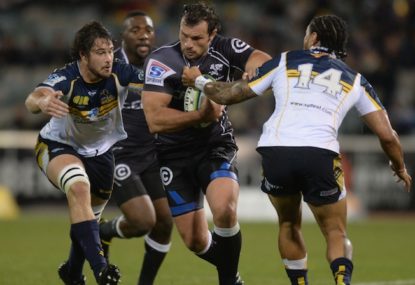There are few competitions in the world with the heritage of the Currie Cup. It’s existence since 1889 makes it one of the oldest provincial competitions in the world.
In the amateur era even Zimbabwe and Namibia took part in the Currie Cup, making it the premier African rugby competition for many years.
Sadly politics, financial constraints and poor economies have removed them from participation.
>> Full Wallabies squad, positions and news
However the Currie Cup has always been the mainstay of South African rugby, and with the ever expanding Super Rugby tournament the Currie Cup has taken a back seat.
It’s often seen as an afterthought, squeezed in between the June Test series and November internationals, with little or no participation by the Springbok players on duty elsewhere.
It has been my opinion for some time that Super Rugby as an entity is morphing into a global fiasco, which should be side-lined by SARU.
After doing some research on the subject, which is rather challenging due to information not being readily available for analysis, I have ascertained the following information.
In 2013, SARU received $10 million for the 33 matches of Currie Cup broadcasted by Super Sport. If you average that per game is comes to $300,000 per match.
In 2013 the average attendance per Super Rugby match in South Africa was 26,791, compared to the average attendance of 16,337 for the Currie Cup.
Considering that 80 per cent of these matches were a duplication of the Super Rugby matches it is understandable that there would be a decline in the spectator numbers for the Currie Cup. What must also be taken into account is that Griquas only averaged 7627 per match, which brought the overall average attendance down significantly.
If SARU were to withdraw from Super Rugby and instead focus on developing the Currie Cup premier division into a “French Top 14” by encompassing all 14 provinces into the tournament, it would mean that the number of matches in the Currie Cup would increase from 33 to 101 including finals.
Now certainly one would argue that it wouldn’t be possible to move towards a 14-team competition immediately after leaving Super Rugby, however if you consider that SARU has increased the Currie Cup Premier division to eight teams for this year, that would be the starting point for 2016.
By adding one team per year after 2016 would mean that by 2022 all fourteen teams would be participating in the Currie Cup Premier division, allowing 14 squads of 35 players to be contracted professionally in South Africa.
After doing some research into the professional sports leagues in the USA, most US sports leagues where players have antitrust and labor rights, their representative unions have negotiated for the players to keep between 45 and 50 per cent of most sports-related revenues, including broadcasting and gate revenue.
I will focus my proposal on these two revenue types only.
Broadcasting revenue
Based on the figures available, 101 matches would provide SARU with Rand 303 million ($30.3 million) per season. This equates to Rand 3 million ($300,000) per match. Working on the basis of 45 per cent of the broadcasting revenue for player salaries and breaking it down per player – two teams with a squad of 35 each – would provide each player with Rand 19,285 ($1928) per match or Rand 501,428 ($50,143) per season.
The broadcasting revenue paid to players would essentially be a central contracting fee by SARU to each premiership player.
Gate revenue
Considering the fact that the spectator numbers are likely to increase with the demise of Super Rugby in South Africa you could look at a scenario where top provinces could earn a significant windfall through the gates.
A cheap Currie Cup ticket is around Rand 80 ($8), which compared to most other countries is ridiculously low. By increasing it to Rand 100 ($10), it could provide a significant increase. For example, the Western Province would get an additional income of Rand 3 million ($300,000) per match on an estimated number of 30,000 spectators, which equates to Rand 31 ($3.1) million gate revenue per Currie Cup season.
If 45 per cent of gate revenue is allocated towards player salaries and paid per player involved in the matchday 22, such a player could earn an additional income of Rand 1.4 million ($140,000) if he played all 26 matches for his province.
Of course that would be unlikely as a percentage would have to be kept back for injured players who would not be available for all 26 matches.
The benefit of paying performing players is that performance and form would be rewarded.
Summation
South Africa will not be able to compete with the Northern Hemisphere in player salaries, but growing the game domestically is a must for the future of the game. The transformation would benefit, as all teams would compete on equal footing and the population at large would become more interested in the game, thus growing our market and revenue.
It has to start somewhere. Players will leave in droves for overseas contracts if this happens, but that is not necessarily a bad thing in the long term. It will flood the market with players, and some would simply have no choice but to stay home. If a player playing for a top province can earn close to Rand 2 million ($200,000) he is not doing that badly.
The SARU could add top-up contracts to the top 45-60 players playing in the Currie Cup to ensure it keeps the best players at home. Travel costs will be much lower and ultimately the Currie Cup would be able to stand on its own financially if it lives within its means.
Private ownership would also become a real possibility, where the contracted players still belong to SARU, but each province will be able to add to the salaries of their players without any interference from SARU.





























































































